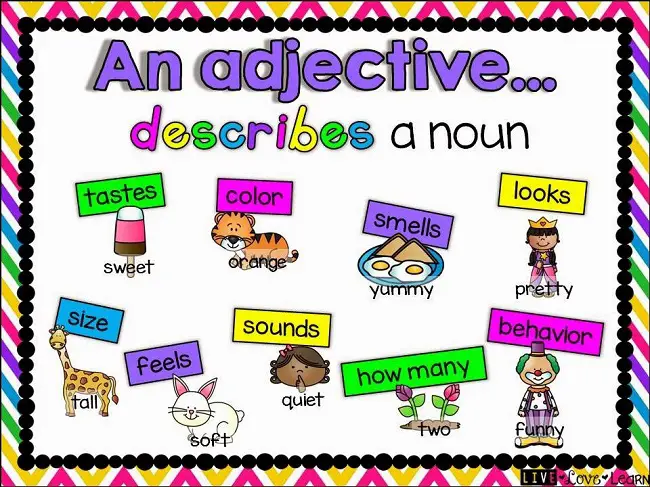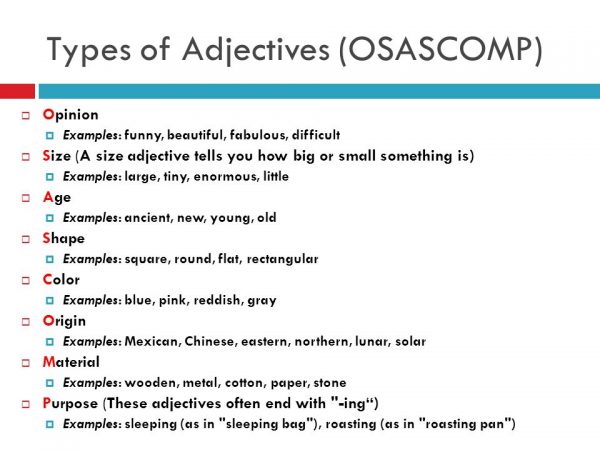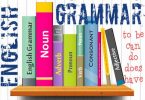Table of Contents
I) What Are Adjectives?
Adjectives are words that describe or modify other words, making your writing and speaking much more specific, and a whole lot more interesting. Words like small, blue, and sharp are descriptive, and they are all examples of adjectives. Because adjectives are used to identify or quantify individual people and unique things, they are usually positioned before the noun or pronoun that they modify.
Examples:
- That is a cute puppy.
- She likes a high school senior.
Adjectives can also act as complements. Complements complete a sentence when the verb is “to be.” Not every complement is an adjective, but some adjectives can be complements
Examples:
- She is tall.
- He is smart, handsome, and rich.
- This tent is malodorous.
II) Types of adjectives:
There are different types of adjectives based upon their effect on a noun and what do they tell about the noun. However; there are five main categories of adjectives that you should know.
1.Descriptive adjectives:
Among the different types of adjectives, descriptive adjectives (careless, black, small, long, fat, English, Mediterranean, three-cornered).are the most numerous. Remember that adjectives modify or describe nouns only and not verbs. Adjectives describe nouns that refer to action (kind act, hard work); state that comes after linking verbs (feel tired, was excited), or quality (strong wind, sad story).
Descriptive adjectives are the most numerous of the different types of adjectives. These adjectives describe nouns that refer to action, state, or quality (careless, dangerous, excited, sad, black, white, big, small, long, fat, English, Mediterranean, three-cornered).
Examples:
- dangerous chemicals
- green vegetables
- a square box
- a big nose
- a tall tree
- a cold morning
- a powerful motorbike
- English language
- Mediterranean countries
2. Quantitative adjectives:
Quantitative adjectives tell us the number (how many) or amount (how much) of a noun.
These adjectives help to show the amount or the approximate amount of the noun or pronoun. These adjectives can provide exact or not exact numbers; rather they tell us the amount of the noun in relative or whole terms: All, Half, Many, Few, Little, No, Enough, Great, etc.
Examples:
- They have finished most of the rice.
- Many people came to visit the fair.
- He has eaten three apples.
- I don’t have enough girlfriends
3. Demonstrative adjectives:
These adjectives are used to point out or indicate a particular noun or pronoun using the adjectives: This, That, These and Those.
Examples:
- That bag belongs to Neil.
- Try using this paintbrush in art class.
- I really like those shoes.
- These flowers are lovely.
Demonstrative adjectives always come before the word they’re modifying:
- This — Used to refer to a singular noun close to you.
- That — Used to refer to a singular noun far from you.
- These — Used to refer to a plural noun close to you.
- Those — Used to refer to a plural noun far from you.
4. Possessive adjectives:
Possessive adjectives are used to show possession or ownership of something. While we use them when we refer to people, it is more in the sense of relationship than ownership.
Some of the most common possessive adjectives include:
- My — Belonging to me
- His — Belonging to him
- Her — Belonging to her
- Their — Belonging to them
- Your — Belonging to you
- Our — Belonging to us
Examples:
- Our cars are expensive
- My pen is black
5. Distributive adjectives
Adjectives which are used to refer people or things individually among many are called Distributive Adjectives.
Distributive Adjectives include:
- Each — Every single one of a group (used to speak about group members individually).
- Every — Every single one of a group (used to make generalizations).
- Either — One between a choice of two.
- Neither — Not one or the other between a choice of two.
- Any — One or some things out of any number of choices. This is also used when the choice is irrelevant, like: “it doesn’t matter, I’ll take any of them.”
III) Order of adjectives:
Understanding clearly what adjectives are, how then do we order them when several are strung together in a sentence?
According to Cambridge, if we are writing several adjectives before a noun without a preferred order for emphasis, we can arrange them as follows based on their function:
1. Opinion Adjectives
- good / bad / great / terrible
- beautiful / pretty / sexy / comfortable
- ugly / awful / strange / uncomfortable
- delicious / disgusting / tasty / nasty
- important / excellent / wonderful / brilliant
- funny / interesting / boring
2.General Size Adjectives
- big / huge / tall / long / enormous / gigantic
- small / little / tiny / short / minuscule
3. Age adjectives
- old / ancient
- new / young
4. Shape Adjectives
- Round / square / triangular / rectangular / flat
5. Color Adjectives
- red, blue, yellow, etc.
6. Nationality/Origin Adjectives
- Italian, Japanese, Thai, German, French, etc.
7. Material Adjectives
- Gold, silver, copper
- Cotton, leather, polyester, wool, silk, velvet, nylon
- Wooden, stone, diamond, plastic
8. Purpose Adjectives
- running shoes
- a sleeping bag
- a flower vase
- a frying pan
- a tennis racket
Here are some examples for the order mentioned above:
- I have a black, Italian, leather coat. (color, origin, material)
- These are delicious, huge, round cookies. (opinion, size, shape)
- My friend married a tall, fair, Japanese man. (size, color, origin)
- I have a shiny, small, square, metal vase. (opinion, size, shape, material)
- I bought an oval, antique, coffee table. (shape, age, purpose)
IV) Conclusion
So, whenever you forget how to arrange adjectives in a sentence, please keep in mind the mnemonic ” OSASCOMP”, which stands for Opinion; Size; Age; Shape; Color; Origin; Material and Purpose.
To write well or to convey a good idea, it is necessary to remember the position of the adjectives in English. Although studying the order of adjectives in English can help… there reaches a point where you’ll learn them best simply by seeing and hearing them in action. Most native English speakers don’t know the rules of adjective order at all – we just know that it “sounds right” to say “the big red ball” and “sounds wrong” to say “the red big ball.”
As you read and listen to more English, you’ll eventually begin to order the adjectives naturally!







